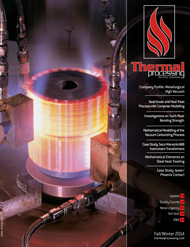Carburizing has an advantage over other gear case hardening processes because it increases a gear’s ability to carry high torque. Carbon control is critical to producing consistency in hardness, microstructure, and overall geometry. The method of process control can affect all of these properties and determine whether the manufacturing process results in fiscal gains or losses. Some of the metallurgical issues associated with poor process control include:
- High retained austenite
- Carbide networks
- Low case hardness
- Shallow case depth
- Excessive microstructural oxidation (also known as intergranular oxidation, or IGO)
- Dirty parts (due to soot formation)
These issues, described in more detail in this article, are a result of poor carbon control during the carburizing process and can result in unintentionally low or high carbon potential.
Excessively High Carbon Potential in the Furnace
It is common practice to use in-situ carbon probes to ensure proper control in achieving desired metallurgical results. Most heat treaters employ a practice of verifying the atmosphere using a method other than carbon probe measurement to ensure that the carbon probe itself is allowing for an accurate calculation of the carbon-richness of the atmosphere. This is important because the carbon probe bases the calculation of carbon on the partial pressure of oxygen in the furnace and uses the assumed prepared atmosphere on which to base this calculation. Alternative methods of verifying carbon percentage are NDIR gas analysis (using CO, CO2, and CH4), carbon wire resistance, shim stock carbon content, and dew point analysis.
Retained Austenite
Excessive retained austenite can create case hardness issues, depending on how much retained austenite is present. In severe cases, the amount of retained austenite can soften the surface of the part and affect its stresses. Austenite is not a stable phase at operating temperature of a gear. Therefore, the austenite can transform while in service if it is not controlled and/or removed during heat treatment. Retained austenite is transformed by temperature and stress. When transformed, the dimensions of the part may change slightly. In many cases, this is detrimental to the function of the gear.
Carbide Formation
Carbide formation occurs when the carbon potential of steel exceeds the saturation point of the carbon in the austenitic microstructure. This amount varies based on the type of steel and the temperature at which the steel is processed. Grain boundary carbides affect the performance of a part negatively: they can increase the tendency to spall, lower the fatigue properties of the metal, and even create tensile stresses when networked. Grinder burn and/or cracking can result during grinding if the surface hardness of the steel is significantly harder than expected due to excessive carbide formation. By most standards, any carbides must be well-dispersed and are usually limited to a certain size and/or percentage of the structure.
Excessive Case Depth
In extreme cases, high carbon potential can drive case depths too deep. Diffusion is a function of time, temperature, and concentration. Gear teeth can be very sensitive to case depth (depending on the tooth profile). Case depths that are too deep can lead to through-carburizing of the tooth, resulting in loss of ductility and reduced fatigue life.
Excessive Distortion
Distortion is due to many factors, including microstructural change of the steel during quenching, physical addition of carbon to the steel, and stress formation and relaxation. The growth of martensite during quenching is directly related to the carbon concentration. The higher the carbon percentage added, the more distortion there is, generally speaking. The addition of carbon to a crystal lattice causes it to expand when martensite is formed. A deeper case generally leads to more distortion. While too much distortion is generally not considered a result of poor atmosphere control, a lack of control can lead to more distortion.
Dirty Parts
The cleanliness of parts can be affected by the furnace atmosphere. A rich atmosphere with high carbon can lead to soot formation in the furnace. The soot can affect how well the steel accepts carbon in later stages of the process. In addition, soot can act as a barrier if it is deposited on the surface of parts and if it is thick enough to inhibit gas exposure to the surface of the part. Dirty parts also require more subsequent processing to meet cleanliness requirements. In today’s world, where lean manufacturing is the key to success, additional processing steps add cost to the part. Manufacturers expect parts to emerge from heat treatment cleaner than what they were going into heat treatment.
Conclusion
It is critical that carbon control and sensors be properly used to ensure that the carbon potential in the furnace is not greater than the controlling variable. As discussed, higher carbon can have negative impact on part performance. Process assurance can be achieved in a number of different ways, but it is important to include a verification of the furnace atmosphere using an alternative method. Upon verification, a procedure should be in place to ensure that the carbon variable being controlled is adjusted. Every true carbon controller manufactured today incorporates an algorithm to adjust the calculation of carbon with respect to variances from the prepared atmosphere or sensor readings.































